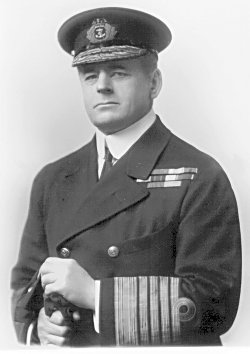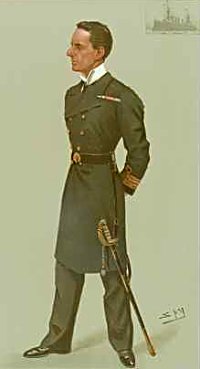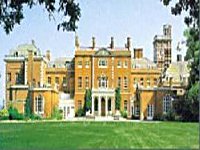

Sir Hedworth Meux entered parliament as Unionist MP for Portsmouth in a bye-election in 1914, the seat having become vacant when Lord Charles Beresford was elevated to the peerage as Baron Beresford. Meux was popular in the House of Commons and several times spoke vigorously on naval subjects, but he was not really interested in parliamentary work, and retired at the 1918 general election.
Behind this somewhat bland record of his time as Member of Parliament for Portsmouth lay a far more interesting story. For a start, his given surname was not Meux.
Hedworth Lambton was born in London on 5 July 1856, the third son of George Frederick D'Arcy Lambton, second earl of Durham (1828–1879), and his wife, Lady Beatrix Frances (d. 21 Jan 1871). He was educated at Cheam School and entered the Britannia as a cadet in 1870. He went to sea in December 1871, sailing in the frigate Endymion, of the channel squadron, and later in the flagship Agincourt, under Sir Beauchamp Seymour. From 1876 to March 1879 he served as sub-lieutenant in the flagship Alexandra, in the Mediterranean under Sir Geoffrey Hornby. In 1880, as flag lieutenant to his old chief Sir Beauchamp Seymour he was present at the bombardment of Alexandria (11 July 1882). In July 1886 he returned to the Mediterranean in command of the sloop Dolphin, and in February 1888 he was appointed to command the royal yacht Osborne, a post he held until he was promoted captain in 1889. From 1890 to 1892 he was flag captain to Charles Hotham in the Warspite on the Pacific station.

From 1894 until 1897 Lambton was naval private secretary to Earl Spencer. In this important office Lambton's judgement on senior officers' appointments was well regarded though he made few friends amongst the officers with whom he dealt through the lack of consideration which he showed them, although he was far junior to most of them in rank and to all of them in age.
In 1897 Lambton went to the China station in command of the large protected cruiser Powerful with her sister ship, the Terrible (commanded by Captain Scott), the largest warship of her day and on their voyage home in October 1899 he was diverted to Durban, at a critical time early in the South African War. On his way he called at Mauritius, and on his own initiative embarked the 2nd battalion, South Yorkshire regiment. Sir George White, commanding at Ladysmith, had been sending urgent messages for more powerful guns. Captain Percy Scott, in the Terrible, which had arrived at the Cape on its way to replace the Powerful on the China station, improvised field-carriages for naval guns, and with four long 12-pounders and two 4.7 inch guns Lambton landed with a naval brigade and arrived at Ladysmith on 30 October, just in time to prevent its surrender to the besieging Boers. The naval guns, though short of ammunition, countered the Boer artillery throughout the siege, for which the naval brigade gained much press coverage and praise. Lambton was created CB, and on the arrival of the Powerful in England was welcomed with great popular enthusiasm.

During the Boer War, the plight of the British Army had made headline news back in England and the defence of Ladysmith had made a particular impression on Valerie Susie Meux the widow of Sir Henry Brent Meux, third baronet, a brewer, of Theobald's Park, Waltham Cross. On hearing of the landing of the naval guns for the defence of Ladysmith, she had ordered, at her own expense, six naval 12-pounders on travelling carriages to be made at Elswick and sent to Lord Roberts in South Africa. They were known as the Elswick battery and though of limited use were much appreciated by the army.
On his return to England, Lambton had called on Lady Meux to describe the work of her guns at Ladysmith, and to praise her patriotic action in sending similar guns to the front. Touched by this tribute, Lady Meux, after making many wills, decided to make Lambton her heir on the sole condition that he changed his name to Meux. She died in 1910 and Lambton changed his name by royal licence in September 1911 and inherited Theobald's Park, residence of Lord Burghley in the 16th Century.
After leaving parliament he devoted much of the remaining part of his life to horse breeding and died on 20 September 1929 at Danebury, an estate which he had bought near Stockbridge, Hampshire. His will was proved at £910,465 gross, with net personalty £734,265. He had no children, and he left his fortune, subject to his widow's interest, to her grandson Sir Ian Hedworth John Little Gilmour, third baronet (b. 1926), later a Conservative MP and cabinet minister.
Tim Backhouse
Southsea, 2007
REFERENCES
The Dictionary of National Biography, author V. W. Baddeley, rev. Roger T. Stearn